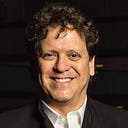Goethe’s Faust And Music
Music and Literature have always been intertwined. Indeed, the great epic myths, like Homer’s Odyssey, were originally sung and not recited.
Few pieces of literature, however, have had the musical impact of Goethe’s Faust. With it’s stark characterizations, sex, and healthy dose of the supernatural, Faust has been a perfect foil for all musical idioms, from Schubert’s deceptively simple song, Gretchen am Spinnrade, to multiple operas and symphonies.
The three pieces I’m conducting this week in Concepción, Chile were all inspired by Faust, yet are from three distinct composers and time periods. The oldest, Mendelssohn’s Die erste Walpurghisnacht, ends the program and, along with anorchestra, requires three soloists and a choir. It is no surprise that Mendelssohn chose to put to music this particular scene from Faust, which is a play within a play as the ghouls, witches, and goblins reenact Shakespeare’s Midsummer Night’s Dream.
The piece that begins the program, Wagner’s Eine Faust Overture, was originally intended to be the first movement of a Faust Symphony that Wagner was contemplating. When he decided against this, he greatly expanded this first movement into this concert overture. What is extraordinary is that Wagner was able to distill the entire story within the span of a little over ten minutes. It’s one of the few pieces that Wagner wrote solely for the concert stage.
The most contemporary piece on the program and the piece that ends the first half, Prokofiev’s Symphony №3, is music that Prokofiev originally used for his opera, The Fiery Angel. In Act 4, for comic relief, Faust and Mephistopheles appear in a tavern scene that is very reminiscent of the tavern scene in Goethe’s play. Indeed, with its inclusion of demonic possession, eroticism, and witchcraft, the entire plot of The Fiery Angel is very similar to Faust.
The Third Symphony was premiered in 1929 and Prokofiev considered this symphony representative of his best work. For me, each of its four movements represent key characters and scenes from Goethe’s Faust. The first movement introduces the strong, yet very human character of Faust, as well as the demonic and all-encompassing persona of Mephisto. The second movement embodies the character of Margarete (Gretchen) and the love shared between her and Mephisto. The third movement represents, like the Mendelssohn, the demonic frenzy of Walpurghisnacht. And the final movement is Mephisto and his domination and possession of Faust.
I have always believed that the music chosen for any concert must have an interrelationship, and this program is such an example. It is my hope that this concert will create a desire to explore Goethe’s great play, as well as further listening of all of the wonderful pieces that were composed with Faust as an inspiration.
